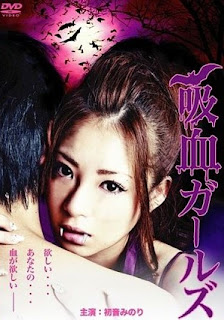Director: Alain Vézina
Release date: 1995
Contains spoilers
You may be aware that I am a fan of the story
la Morte Amoureuse, a short dating back to 1836 and penned by Theophile Gautier. The story was captured well in the episode of the Hunger entitled
Clarimonde – though, whilst mainly fiercely accurate to the source, they did expunge all vampiric elements.
It was only very recently that I became aware of this film, through Bill at the
Uranium Café, and a rare beast it is as well – utterly missing from IMDb. It is based on Gautier’s story and does keep the vampiric elements (in fact expands on them) but also modernises the story. This updating, along with a soundtrack that was, I guess, meant to emulate the heights of 90s synth-soundtrack styling, manages to undermine the atmosphere that the film should have carried – but that said it doesn’t do everything wrong.
 |
| breaking vows on the altar |
In a kitchen housekeeper Thérése (Denise Bouchard) talks about the ills of the village and the thunderstorm that rages as her companion Father Sylvain (Pierre Mailloux) looks distracted, not eating his soup. He eventually excuses himself but cannot settle and so goes through to his church. The altar seems to glow and a veiled woman, a bride we might suppose, appears – holding her arms to him. He goes to her and takes her (very quickly) on the altar.
 |
| the corpse |
When he has finished he looks at her and sees that the woman has transformed into a corpse, desiccated and burnt. There is a disturbingly intimate shot of part of her anatomy and the priest is distraught, questioning what he has done. Thérése is looking for the priest when she hears the church bell ring – she rushes in to find him hanging by the bell rope.
 |
| Marc with Catherine |
Marc (Luc Pilon) is a young (and disturbingly happy) priest living in the city. He receives orders to take over the parish of Father Sylvain. He says goodbye to his father, in background later on we discover that his father was never happy that he became a priest, and travels North. He finds the church idyllic and has plans to install a choir – Thérése becomes less and less enamoured with the young man, and some of his radical ideas, especially when he makes the acquaintance of Albert (Jerôme Ricard).
 |
| marking the burning |
Albert is a hippy eco-warrior, hanging out with others – ostensibly – to clean the beach but really to get drunk and high. He shows Marc a marker stone that he thinks is from a native tribe but Mark recognises as Latin – though he confuses the pentagram with the Star of David. It turns out to be a marker of where a local priest burned two ‘witches’ to death. Marc also meets Albert’s friend Catherine (Virgine Dubois) and it is clear that there is a chemistry between them that he tries to deny.
 |
| blood from the claw |
It doesn’t take much to guess that Catherine is our vampire. She was the daughter of the alleged ‘witches’ and was nearly abused by the priest when she was rescued by something unseen, a something that fed her blood on its claw. We also meet a priest named Clément (Yvan Roy), he had been the parish priest until he tried to kill himself (he failed, obviously) and – on realising that Sylvain is dead – he leaves his monastery to do what needs to be done.
 |
| Demonic Sylvain |
You see in this Catherine makes each priest fall in love with her and then drives them to suicide. She feeds on the suicide (it would appear) and the priest returns from the grave as a vampire as well. Of course, tying vampirism and suicide together is reaching back to original folklore and always welcome. We see a demonic version of Sylvain in one of Clément’s visions – though this was a poor make-up moment. We also see him as a semi-decayed, fanged vampire with a messiah complex.
 |
| burning in holy water |
All this strays further and further from the original. We see a stake (inscribed, it seemed, with occult symbols) and discover that fire purifies. The original story made play of holy water and this does take a cue from that and we have Marc blessing the lake and Sylvain burning within it. Daylight is not an issue for Catherine as we see her during the day and, as we see her in the church, we assume that hallowed ground is not an issue either.
 |
| Virgine Dubois as Catherine |
Whilst never in danger of winning an Oscar, the acting was fairly good from the principles, maybe not as good when it came to the supporting cast. As I have said, the soundtrack didn’t work for me. The story itself wasn’t original-story compliant but the changes worked more or less. That said I felt we needed a wee bit more concentration on Catherine and Marc to establish their blossoming relationship properly. Some of the effects were poor and the cinematography seemed a little washed out and needed more depth – these elements also conspired against atmosphere. I was also a little disappointed that the genuine sympathy that I felt for the original story protagonists was not as apparent for Catherine and Marc.
 |
| unholy bride |
Is it the greatest vampire film… no, but I have seen much worse and I like the fact that they used Gautier as a basis; that doesn't happen often enough as far as I am concerned. Is it the best version of La Morte Amoureuse? No… that honour stays with Clarimonde – even if that version lost the vampiric elements.
5 out of 10.
At the time of review there is no IMDb page.








































































